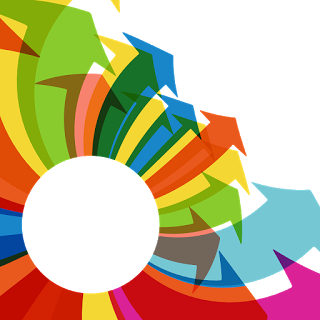Pearl Zhu's Blog, page 1273
November 29, 2016
"CIO Master" Book Tuning #145: Running Digital IT as a Revenue Rain Maker
The payoff of IT digital transformation is not just for the quick win, but to build the long-term business competency.
 Traditional IT organizations are perceived as the cost center, running in an inside-out operation driven mode. Nowadays, with the exponential growth of information and lightweight digital technologies, forward-looking organizations across industrial sectors claim they are in the information management business, and there is a high expectation of IT to drive changes and lead the digital transformation. Therefore, the invisible divide IT vs. Business needs to go away, and CIOs should market themselves and advocate IT as an integrated component of the company, in order to run IT as an innovation engine and revenue generator for the business. CIOs must set priority right and have an IT transformation checklist on how to answer the questions such as: How do we get revenues now? How will we do in the future? How should IT help the company win businesses? How can IT contribute to customer acquisition and retention? And how to run digital IT as a revenue rainmaker?
Traditional IT organizations are perceived as the cost center, running in an inside-out operation driven mode. Nowadays, with the exponential growth of information and lightweight digital technologies, forward-looking organizations across industrial sectors claim they are in the information management business, and there is a high expectation of IT to drive changes and lead the digital transformation. Therefore, the invisible divide IT vs. Business needs to go away, and CIOs should market themselves and advocate IT as an integrated component of the company, in order to run IT as an innovation engine and revenue generator for the business. CIOs must set priority right and have an IT transformation checklist on how to answer the questions such as: How do we get revenues now? How will we do in the future? How should IT help the company win businesses? How can IT contribute to customer acquisition and retention? And how to run digital IT as a revenue rainmaker?
IT can become known as a revenue rainmaker by associating its efforts directly with sources of income: IT needs a shift from inside-out operation driven to outside-in customer centric. You are able to spot the opportunities to increase revenues. IT has two sets of customers, internal business users as well as external end customers. IT needs to provide efficient platforms and tools to improve productivity and efficiency of internal customers; but more importantly, these days, looking for solutions which will directly benefit the external end customer will improve the competitive advantage and in-turn bring in increased revenue. Business people with revenue-enhancement projects often don't request IT projects to support them because they don't know what IT can do. CIOs have to communicate with the business to find these projects and then talk with the business managers responsible for them about what could be done. CIOs should also work with the business on plugging revenue leakages, business unit managers need back to back KPIs with CIOs on applications/service deliveries, so the organization sees "oneness," is superior to the sum of pieces.
IT entrepreneurialism is about running IT as a business: IT entrepreneurialism becomes a new fixture for management in their efforts to substantiate their competitive position, effect market landscape, and drive new revenue growth.The IT organization should provide guidance, support, assistance and direction in the application and adoption of information technology solutions enabling business objectives! The first thing is to stop calling IT initiative, profits and ROIs should be the driving force behind any IT project. IT projects should be called a business project with a clear objective, business justification, and full alignment with overall company’s objectives, otherwise, they do not exist. Like any other business initiative from another part of the company, developing a compelling strategic business case is especially critical when an initiative is difficult to monetize. That is, attach believable dollar values to identified benefits flows.
 Make sure the executive team first understands what it needs to drive future business growth and revenue growth: CIOs will contribute to revenue generation when they are part of the senior executives' team responsible for the strategy making and revenue targets. Companies are recognizing that IT is roughly coupled to the business strategy, and it is a very good sign about how the companies will deliver value. CIOs have to be an integral part of the top leadership team for driving business value, to bring technology vision in strategy making, envisioning the future products strategy or any others. IT leaders have to be hand-in-glove with the business executives to map out the vision, fully aligned with the business executives in articulating business strategy. Put the framework in place to map the strategic objectives into KPIs and then determine what technology investments will accelerate the changes you want to see in your KPIs. Launch innovative delivery channels for improving sales revenues and ultimately net profit.
Make sure the executive team first understands what it needs to drive future business growth and revenue growth: CIOs will contribute to revenue generation when they are part of the senior executives' team responsible for the strategy making and revenue targets. Companies are recognizing that IT is roughly coupled to the business strategy, and it is a very good sign about how the companies will deliver value. CIOs have to be an integral part of the top leadership team for driving business value, to bring technology vision in strategy making, envisioning the future products strategy or any others. IT leaders have to be hand-in-glove with the business executives to map out the vision, fully aligned with the business executives in articulating business strategy. Put the framework in place to map the strategic objectives into KPIs and then determine what technology investments will accelerate the changes you want to see in your KPIs. Launch innovative delivery channels for improving sales revenues and ultimately net profit.
Let revenue generation or profit increase become the focus vs. cost savings/ optimization. The payoff of IT digital transformation is not just for the quick win, but to build the long-term business competency. In this regard, the focus of digital IT organization should gain more strength as a revenue rainmaker.
CIO Master Order Link on Amazon CIO Master Ordre Link on Barner & Noble CIO Master Order Link On IBooks “CIO Master” Book Preview Quote Collection III “CIO Master” Book Preview Quote Collection II “CIO Master” Book Preview Quote Collection I, Slideshare Presentation “CIO Master” Book Preview Conclusion Running IT as Digital Transformer “CIO Master” Book Preview: Chapter 9 IT Agility “CIO Master” Book Preview: Chapter 8 Three "P"s in Running Digital IT “CIO Master” Book Preview: Chapter 7 IT Innovation Management “CIO Master” Book Preview: Chapter 6 Digital Strategy-Execution Continuum "CIO Master” Book Preview: Chapter 5 Thirteen Digital Flavored IT “CIO Master” Book Preview: Chapter 4 CIO as Talent Master Introduction “CIO Master” Book Preview: Chapter 3 “CIOs as Change Agent” Introduction “CIO Master” Book Preview: Chapter 2 “CIOs as Digital Visionary” Introduction “CIO Master” Book Preview: Chapter 1 “Twelve Digital CIO Personas” Introduction "CIO Master - Unleash the Digital Potential of IT" Introduction
"CIO Master - Unleash the Digital Potential of IT" Book Preview Follow us at: @Pearl_Zhu
 Traditional IT organizations are perceived as the cost center, running in an inside-out operation driven mode. Nowadays, with the exponential growth of information and lightweight digital technologies, forward-looking organizations across industrial sectors claim they are in the information management business, and there is a high expectation of IT to drive changes and lead the digital transformation. Therefore, the invisible divide IT vs. Business needs to go away, and CIOs should market themselves and advocate IT as an integrated component of the company, in order to run IT as an innovation engine and revenue generator for the business. CIOs must set priority right and have an IT transformation checklist on how to answer the questions such as: How do we get revenues now? How will we do in the future? How should IT help the company win businesses? How can IT contribute to customer acquisition and retention? And how to run digital IT as a revenue rainmaker?
Traditional IT organizations are perceived as the cost center, running in an inside-out operation driven mode. Nowadays, with the exponential growth of information and lightweight digital technologies, forward-looking organizations across industrial sectors claim they are in the information management business, and there is a high expectation of IT to drive changes and lead the digital transformation. Therefore, the invisible divide IT vs. Business needs to go away, and CIOs should market themselves and advocate IT as an integrated component of the company, in order to run IT as an innovation engine and revenue generator for the business. CIOs must set priority right and have an IT transformation checklist on how to answer the questions such as: How do we get revenues now? How will we do in the future? How should IT help the company win businesses? How can IT contribute to customer acquisition and retention? And how to run digital IT as a revenue rainmaker?IT can become known as a revenue rainmaker by associating its efforts directly with sources of income: IT needs a shift from inside-out operation driven to outside-in customer centric. You are able to spot the opportunities to increase revenues. IT has two sets of customers, internal business users as well as external end customers. IT needs to provide efficient platforms and tools to improve productivity and efficiency of internal customers; but more importantly, these days, looking for solutions which will directly benefit the external end customer will improve the competitive advantage and in-turn bring in increased revenue. Business people with revenue-enhancement projects often don't request IT projects to support them because they don't know what IT can do. CIOs have to communicate with the business to find these projects and then talk with the business managers responsible for them about what could be done. CIOs should also work with the business on plugging revenue leakages, business unit managers need back to back KPIs with CIOs on applications/service deliveries, so the organization sees "oneness," is superior to the sum of pieces.
IT entrepreneurialism is about running IT as a business: IT entrepreneurialism becomes a new fixture for management in their efforts to substantiate their competitive position, effect market landscape, and drive new revenue growth.The IT organization should provide guidance, support, assistance and direction in the application and adoption of information technology solutions enabling business objectives! The first thing is to stop calling IT initiative, profits and ROIs should be the driving force behind any IT project. IT projects should be called a business project with a clear objective, business justification, and full alignment with overall company’s objectives, otherwise, they do not exist. Like any other business initiative from another part of the company, developing a compelling strategic business case is especially critical when an initiative is difficult to monetize. That is, attach believable dollar values to identified benefits flows.
 Make sure the executive team first understands what it needs to drive future business growth and revenue growth: CIOs will contribute to revenue generation when they are part of the senior executives' team responsible for the strategy making and revenue targets. Companies are recognizing that IT is roughly coupled to the business strategy, and it is a very good sign about how the companies will deliver value. CIOs have to be an integral part of the top leadership team for driving business value, to bring technology vision in strategy making, envisioning the future products strategy or any others. IT leaders have to be hand-in-glove with the business executives to map out the vision, fully aligned with the business executives in articulating business strategy. Put the framework in place to map the strategic objectives into KPIs and then determine what technology investments will accelerate the changes you want to see in your KPIs. Launch innovative delivery channels for improving sales revenues and ultimately net profit.
Make sure the executive team first understands what it needs to drive future business growth and revenue growth: CIOs will contribute to revenue generation when they are part of the senior executives' team responsible for the strategy making and revenue targets. Companies are recognizing that IT is roughly coupled to the business strategy, and it is a very good sign about how the companies will deliver value. CIOs have to be an integral part of the top leadership team for driving business value, to bring technology vision in strategy making, envisioning the future products strategy or any others. IT leaders have to be hand-in-glove with the business executives to map out the vision, fully aligned with the business executives in articulating business strategy. Put the framework in place to map the strategic objectives into KPIs and then determine what technology investments will accelerate the changes you want to see in your KPIs. Launch innovative delivery channels for improving sales revenues and ultimately net profit.Let revenue generation or profit increase become the focus vs. cost savings/ optimization. The payoff of IT digital transformation is not just for the quick win, but to build the long-term business competency. In this regard, the focus of digital IT organization should gain more strength as a revenue rainmaker.
CIO Master Order Link on Amazon CIO Master Ordre Link on Barner & Noble CIO Master Order Link On IBooks “CIO Master” Book Preview Quote Collection III “CIO Master” Book Preview Quote Collection II “CIO Master” Book Preview Quote Collection I, Slideshare Presentation “CIO Master” Book Preview Conclusion Running IT as Digital Transformer “CIO Master” Book Preview: Chapter 9 IT Agility “CIO Master” Book Preview: Chapter 8 Three "P"s in Running Digital IT “CIO Master” Book Preview: Chapter 7 IT Innovation Management “CIO Master” Book Preview: Chapter 6 Digital Strategy-Execution Continuum "CIO Master” Book Preview: Chapter 5 Thirteen Digital Flavored IT “CIO Master” Book Preview: Chapter 4 CIO as Talent Master Introduction “CIO Master” Book Preview: Chapter 3 “CIOs as Change Agent” Introduction “CIO Master” Book Preview: Chapter 2 “CIOs as Digital Visionary” Introduction “CIO Master” Book Preview: Chapter 1 “Twelve Digital CIO Personas” Introduction "CIO Master - Unleash the Digital Potential of IT" Introduction
"CIO Master - Unleash the Digital Potential of IT" Book Preview Follow us at: @Pearl_Zhu
Published on November 29, 2016 22:39
Running Digital IT as a Revenue Rain Maker
 Traditional IT organizations are perceived as the cost center, running in an inside-out operation driven mode. Nowadays, with exponential growth of information and lightweight digital technologies, forward-looking organizations cross industrial sectors claim they are in the information management business, and there is a high expectation of IT to drive changes and lead digital transformation. This invisible divide IT vs. Business needs to go away, and CIOs should market themselves and the IT as an integrated component of the company, in order to run IT as innovation engine and revenue generator for the business. CIO must set priority right and have an IT management checklist on how to answer the questions such as: How do we get revenues now? How will we do in the future? How should IT help the company win businesses? How can IT contribute to customer acquisition and retention? And how to run digital IT as a revenue rain maker?
Traditional IT organizations are perceived as the cost center, running in an inside-out operation driven mode. Nowadays, with exponential growth of information and lightweight digital technologies, forward-looking organizations cross industrial sectors claim they are in the information management business, and there is a high expectation of IT to drive changes and lead digital transformation. This invisible divide IT vs. Business needs to go away, and CIOs should market themselves and the IT as an integrated component of the company, in order to run IT as innovation engine and revenue generator for the business. CIO must set priority right and have an IT management checklist on how to answer the questions such as: How do we get revenues now? How will we do in the future? How should IT help the company win businesses? How can IT contribute to customer acquisition and retention? And how to run digital IT as a revenue rain maker?IT can become known as a revenue rainmaker by associating its efforts directly with sources of income: IT needs a shift from inside-out operation driven to outside-in customer centric. You are able to spot the opportunities to increase revenues. IT has two sets of customers, internal business users as well as external end customers. IT needs to provide efficient platforms and tools to improve productivity and efficiency of internal customers; more importantly, these days, looking for solutions which will directly benefit the external end customer will improve the competitive advantage and in-turn bring in increased revenue. Business people with revenue-enhancement projects often don't request IT projects to support them because they don't know what IT can do. CIOs have to communicate with the business to find these projects and then talk with the business managers responsible for them about what could be done. CIOs should also work with the business on plugging revenue leakages, business unit managers need back to back KPIs with CIOs on applications/service deliveries, so the organization sees "oneness."
IT entrepreneurialism is about running IT as a business: IT entrepreneurialism becomes a new fixture for management in their efforts to substantiate their competitive position, effect market landscape, and drive new revenue growth.The IT organization provides guidance, support, assistance and direction in the application and adoption of information technology solutions enabling business objectives! The first thing is to stop calling it an IT initiative, profits and ROIs should be the driving force behind any IT project. IT projects should be called a business project with a clear objective, business justification, and full alignment with overall company’s objectives, otherwise, they do not exist. Like any other business initiative from another part of the company, developing a compelling strategic business case is especially critical when an initiative is difficult to monetize: That is, attaching believable dollar values to identified benefits flows.
 Make sure the executive team first understands what it needs to drive future business growth and revenue growth: CIOs will contribute to revenue generation when they are part of the senior executives' team responsible for the strategy making and revenue targets. Companies are recognizing that IT is roughly coupled to the business strategy, and it is a very good sign about how the companies will deliver value. CIOs have to be an integral part of driving business value, to bring technology vision in strategy making, envisioning the future products strategy or any others. IT leaders have to be fully aligned with the business executives in articulating business strategy. Information executives have to be hand-in-glove with the business owners to map out the vision/ strategy. Put the framework in place to map the strategic objectives into KPIs and then determine what technology investments will accelerate the changes you want to see in your KPIs. Launch innovative delivery channels for improving sales revenues and ultimately net profit.
Make sure the executive team first understands what it needs to drive future business growth and revenue growth: CIOs will contribute to revenue generation when they are part of the senior executives' team responsible for the strategy making and revenue targets. Companies are recognizing that IT is roughly coupled to the business strategy, and it is a very good sign about how the companies will deliver value. CIOs have to be an integral part of driving business value, to bring technology vision in strategy making, envisioning the future products strategy or any others. IT leaders have to be fully aligned with the business executives in articulating business strategy. Information executives have to be hand-in-glove with the business owners to map out the vision/ strategy. Put the framework in place to map the strategic objectives into KPIs and then determine what technology investments will accelerate the changes you want to see in your KPIs. Launch innovative delivery channels for improving sales revenues and ultimately net profit.Let revenue generation or increase become the focus vs. cost savings/ optimization. The payoff of IT digital transformation is not just for the quick win, but to build the long-term business competency. In this regard, the payoff of digital IT organization should gain more strength as a revenue rainmaker. Follow us at: @Pearl_Zhu
Published on November 29, 2016 22:39
November 28, 2016
The New Book “Unpuzzling Innovation” Book Introduction Chapter 6 Innovation Paradox
 Innovation is to transform the novel ideas and achieve their business value. The purpose of innovation management is not to promote innovation, but to manage innovation in a structural way. But what’s the best approach to understanding and managing these innovation paradoxes: Can money buy innovation? Do rules restrict innovation? Does priority stifle innovation? Will Systems Thinking limit creativity? Is innovation management a waste? Can you transform an idea into sustainable benefit without Innovation Management?
Innovation is to transform the novel ideas and achieve their business value. The purpose of innovation management is not to promote innovation, but to manage innovation in a structural way. But what’s the best approach to understanding and managing these innovation paradoxes: Can money buy innovation? Do rules restrict innovation? Does priority stifle innovation? Will Systems Thinking limit creativity? Is innovation management a waste? Can you transform an idea into sustainable benefit without Innovation Management?The business innovation success is not always proportional with how much money you pour in: There is an underlying assumption that ideation can be down if you invest more. However, based on the variety of innovation studies, the business innovation success is not always proportional to how much money you invest in. Money facilitates innovation, but not guarantees the result. What you are primarily doing is harvesting ideas that have emerged and are waiting to be picked. The money will increase the willingness of employees to give you those ideas. It doesn’t mean though that it will increase the volume of ideas that are available to be collected. There are many human links within the innovation phases and usually implemented in teams. It seems that many companies going through a period of introspection believe that they already implicitly understand the nature of innovation, all too often they perhaps manage a few innovation projects successfully. But they lack the systematic approach to management resource or bridge talent gaps. It is important to build the culture of innovation, to inspire people doing meaningful work and taking the calculated risks. The culture of innovation starts with a culture of participation because employee engagement in the innovation process increases participation.
Breaking rules is indeed an important part of creativity and innovation management: We can’t make the omelet without breaking a few eggs. Creativity is about breaking down the conventional wisdom, and innovation is to pursue the new way doing things. But innovation does need a level of guidance, the paradox is that all creative activities are subversive in questioning the status quo. Setting rules and goals for creativity goes against the very nature of creativity and thus innovation. Ideas shouldn’t be overly evaluated in the ideation phase; overly rigid process or too “pushy” goals will stifle inventiveness and innovation. However, “business creativity” such as using creative thinking for business goals, does require certain “rules.” Innovation is important business activities and capabilities, innovation has to follow a well-defined set of principles to deliver business objectives. Hence, it’s critical to strike the right balance, it takes out-of-the-box thinking and open leadership style to spark innovation. But the right set of rules and frameworks are also important for innovation enablement.
 Efficiency and innovation just have to learn to live and function together: An obsession with the rigidity of efficiency stunts the innovation creation process. Innovation is fluid and often focus on the long-term business growth, but lower profitability in the short-term. Efficiency and short-term goal orientation often divert focus from innovation in general. Hence, balance is the most challenging continuity regardless of strategic emphasis. As processes yielding results, innovation and efficiency can complement and enhance each other. The greater the efficiency of an organization, the greater the need is for innovation. Efficiency will extract the maximum benefit from a new idea. If an organization is inefficient, it will be inefficient with new ideas. Innovate as early as possible, think it through, execute the process efficiently, fine-tune the cycle along the trail, and orchestrate the innovation symphony.
Efficiency and innovation just have to learn to live and function together: An obsession with the rigidity of efficiency stunts the innovation creation process. Innovation is fluid and often focus on the long-term business growth, but lower profitability in the short-term. Efficiency and short-term goal orientation often divert focus from innovation in general. Hence, balance is the most challenging continuity regardless of strategic emphasis. As processes yielding results, innovation and efficiency can complement and enhance each other. The greater the efficiency of an organization, the greater the need is for innovation. Efficiency will extract the maximum benefit from a new idea. If an organization is inefficient, it will be inefficient with new ideas. Innovate as early as possible, think it through, execute the process efficiently, fine-tune the cycle along the trail, and orchestrate the innovation symphony. Innovation is about moving forward. In any business, if you are not moving forward, you are moving backward. There is no standing still. Innovation Management needs to take a balanced approach to deal with those innovation paradoxes smoothly; provide maximal freedom for ideators, and then straightforward process for converting an idea into an innovation, and build innovation as the business long term competency.Follow us at: @Pearl_Zhu
Published on November 28, 2016 22:56
CIOs as “Chief Initiative Officer”: How to Run a High-Mature IT Organization in a Proactive Mode
 Technology is pervasive, business initiatives and digital transformation today nearly always involves some form of technology implementation or information analysis; IT touches both hard business processes and soft human behavior. However, the majority of IT organizations still run in the reactive mode, take the order, fix the symptoms, and keep the lights on, get stuck at the lower level of maturity. With emergent digital trend and the increasing speed of changes, innovation is no longer “nice to have,” but must have the capability to make the organization thrive. IT has the necessary structure/ methodology/tool in shaping the new box of thinking and managing the emergent digital complexity with the characteristics such as hyper-connectivity, hyper-diversity, and hyper-dynamism. And it is strategic imperative to run a high mature IT in a proactive mode.
Technology is pervasive, business initiatives and digital transformation today nearly always involves some form of technology implementation or information analysis; IT touches both hard business processes and soft human behavior. However, the majority of IT organizations still run in the reactive mode, take the order, fix the symptoms, and keep the lights on, get stuck at the lower level of maturity. With emergent digital trend and the increasing speed of changes, innovation is no longer “nice to have,” but must have the capability to make the organization thrive. IT has the necessary structure/ methodology/tool in shaping the new box of thinking and managing the emergent digital complexity with the characteristics such as hyper-connectivity, hyper-diversity, and hyper-dynamism. And it is strategic imperative to run a high mature IT in a proactive mode.CIOs are quite eager and enthusiastic to drive challenging transformation initiatives: Historically CIOs have been frontrunners in transformation initiatives and it is anticipated that they'll bring their technical expertise, business acumen, best/next practices and working knowledge of past transformations into newer initiatives. The CIO as Chief Initiative Officer has become necessary to manage strategic alignment from the C-level to the front lines, and IT-business integration from concept to post-implementation of all initiatives.There should also be strong interaction between Operations leaders and IT leaders and their teams with feedback mechanisms and willingness to find solutions that can support both the business need and build any ROI required to justify the business case. If IT is supporting the business goals in a proactive mode, it will help the company win business. Broadly speaking, at the lower maturity level, IT is an enabling capability to support business. However, when moving up the maturity, IT can become the game changer, and innovation drivers to bring the new opportunity for business growth and customer experience optimization.
IT maturity also depends on how it manages the changes: Traditional IT department is perceived as a change laggard, with controller’s mentality to drag down the business speed to changes.What usually happens is that IT couldn't get the business engaged and then ran out of the way. IT staffs are trained early on to focus on change control as a sort of promotion to the production process and they aren't usually skilled in how it happens. Digital IT needs to be run as a change agent, because IT is at the unique position to oversee business processes, and weave all important business factors -people, process, and technology into the ongoing change capability. IT leaders should animate the transformation and manage transformation initiatives: build up a positive emotional climate, foster business partnership, communicate relentlessly, cool down stressed people before they stress others, be there at the crossroad of the transformation to make sure information and interaction flow in every direction, build up trust by bonding people around clear and benevolent intentions.
 IT is not limiting business’s creativity, but encouraging out of the box thinking as well as systematic innovations: IT can lead the charge in improving business-IT relations by simply not taking their customer for granted and focusing on customers as if they were in a competitive market. It is invaluable for both IT and business to know what's going in each other's space and why. IT and business must rely on each other's strengths and use each other in the most relevant capacity, both parties have to understand exactly how each one operates. The key is engaging at the right level and about the right things to cultivate innovation. It should start at the strategic level, IT, marketing, finance, HR., etc, all have its own subsection of the overall business strategy. The true IT-business partner relationship can move both business and IT forward, and delivery high-performance result. In addition, at the age of complexity and uncertainty, working with vendors/business partners in technology in a consultative manner can often open out ideas since they will be looking for business pain and solutions that IT/Technology can drive and implement. Running IT in a proactive mode also means IT is moving from business-IT alignment to IT-customer alignment, IT can improve every critical process of business, as well as digitalize the touch point of customer experience, to become an outside-in customer-centric organization.
IT is not limiting business’s creativity, but encouraging out of the box thinking as well as systematic innovations: IT can lead the charge in improving business-IT relations by simply not taking their customer for granted and focusing on customers as if they were in a competitive market. It is invaluable for both IT and business to know what's going in each other's space and why. IT and business must rely on each other's strengths and use each other in the most relevant capacity, both parties have to understand exactly how each one operates. The key is engaging at the right level and about the right things to cultivate innovation. It should start at the strategic level, IT, marketing, finance, HR., etc, all have its own subsection of the overall business strategy. The true IT-business partner relationship can move both business and IT forward, and delivery high-performance result. In addition, at the age of complexity and uncertainty, working with vendors/business partners in technology in a consultative manner can often open out ideas since they will be looking for business pain and solutions that IT/Technology can drive and implement. Running IT in a proactive mode also means IT is moving from business-IT alignment to IT-customer alignment, IT can improve every critical process of business, as well as digitalize the touch point of customer experience, to become an outside-in customer-centric organization.The CIO as a “Chief Initiative Officer” means the CIO needs to see beyond the confines of his/her own function by understanding all the moving parts of the business and contribute to the overall growth of the greater living digital organization. Remember that knowledge is power and as the CIO you have the most influential position within the business to make the true proactive contribution to run a high mature organization. Don’t waste the opportunity, seize it. People tend to have high expectation of digital flow, and organizations rely more and more on technology; the IT department has more and more to overcome for improving its agility and maturity and running IT with digital speed.
Follow us at: @Pearl_Zhu
Published on November 28, 2016 22:53
November 27, 2016
The New Book “Unpuzzling Innovation” Introduction Chapter 5 Digital Innovation Next Practices
 The world is becoming more hyper-connect with the latest digital technology advancement. Digital innovation has a broader spectrum with hybrid nature; it is the incremental improvement-radical innovation continuum. Is it possible to integrate the innovative concepts into a comprehensive approach that can generate intelligent solutions to the seemly insurmountable large-scale problems? How to develop digital innovation best and next practices for managing innovation continuum in a structural way?
The world is becoming more hyper-connect with the latest digital technology advancement. Digital innovation has a broader spectrum with hybrid nature; it is the incremental improvement-radical innovation continuum. Is it possible to integrate the innovative concepts into a comprehensive approach that can generate intelligent solutions to the seemly insurmountable large-scale problems? How to develop digital innovation best and next practices for managing innovation continuum in a structural way?Knowledge and practices are relevant to innovation; doing more results in more opportunity for innovation: The essence of innovation is made of trying the new combination of known things. Innovation is a strategic choice. If you want to be an “innovative organization,” you shape your current business structure to match your current stack rank of areas where innovation will reap the most significant benefit. You never know how innovative you might be in some field before encountering the problems and before the adoption of solutions. Innovation is a discipline that if practiced well and understood fully, reads more like a blueprint than science fiction. Innovation is only a strategic choice if you are in possession of some “how-to”s. In addition, emphasizing that innovation is a journey enables people to pace themselves and recognize that innovation is not an on-off switch. There will be ups and downs on the way and you need the resilience to make the journey to completion.
Groom innovation leaders boldly, and develop employees entrepreneurially: To keep innovation alive in the organization, it’s necessary first assure your think tank that you are willing to make an investment with calculated risks. Encourage employees to do things and problem-solving in their own way to bring good results. It’s important to create an environment where people want to work, encourage brainstorming, and the top leaders inspire and respect of sharing ideas and collective insight, find the new stars and let them drive. If you could create a culture that nurtures creativity and innovation, you might be onto something, people will dare to be innovative as long as they know they won’t get penalized for a bad idea and get rewarded for a good one. Business innovation is bravery - it can take you to a whole other place.
 There are two types of measurement of creativity: The problem for building a creative workplace is being able to create a measure that assesses the different dimensions of organizational creativity adequately. Generally speaking, there are two types of measurement: the first type of measurement of creativity in the workplace is through the results, the outcomes of creative thoughts and actions. The second type of assessment is through the innovation drivers, the elements that enhance an organization’s innovation capacity. There must be an appreciation for the organization of the sources of creativity as well as the structures and cultures that will promote innovation. Innovation Management in a workplace is a multi-dimensional pursuit.
There are two types of measurement of creativity: The problem for building a creative workplace is being able to create a measure that assesses the different dimensions of organizational creativity adequately. Generally speaking, there are two types of measurement: the first type of measurement of creativity in the workplace is through the results, the outcomes of creative thoughts and actions. The second type of assessment is through the innovation drivers, the elements that enhance an organization’s innovation capacity. There must be an appreciation for the organization of the sources of creativity as well as the structures and cultures that will promote innovation. Innovation Management in a workplace is a multi-dimensional pursuit.It is really hard to be a consistently innovative company. It requires fine-tuning the organizational structure and culture that nurtures new ideas and is able to profitably execute on those ideas. It is also not easy to walk the talk, develop the best and next practices for experimenting and learning to facilitate both breakthrough innovation and continuous improvement and build innovation capability cohesively.Follow us at: @Pearl_Zhu
Published on November 27, 2016 23:09
Making Sound Decisions via Multidimensional Intelligence
 Intelligence has been defined in several ways. First intelligence is a cognitive process involving rational and abstract thinking. Second, it is the goal- directed and purposeful, which means that all intelligent activities are planned to reach a self-determined goal. Finally, it involves social competence to help individuals adjust to their environmental surroundings. How to make sound decisions via multidimensional intelligence?
Intelligence has been defined in several ways. First intelligence is a cognitive process involving rational and abstract thinking. Second, it is the goal- directed and purposeful, which means that all intelligent activities are planned to reach a self-determined goal. Finally, it involves social competence to help individuals adjust to their environmental surroundings. How to make sound decisions via multidimensional intelligence?High mental ability is important to make effective decisions: Intelligence is the word we use to describe mental ability. Intelligence is the capacity to understand and apply wisdom to the knowledge you are exposed to. There are as many different ways to characterize intelligence as there are different types and forms of information implying on our senses. Our intelligence with regard to any given type of information is a function of our capacity to recognize and interpret patterns, and our consequent ability to use the perceived information for making sound judgments or effective decisions. There are as we all know, varying levels of intelligence; emotional intelligence is a key component of an intellectual mind.
Contextual intelligence is crucial in making sound decisions: An intellectual mind is contextual. Whether someone is "intelligent" or not depends entirely on what you are asking them to accomplish with their brain, often it means making large or small decisions on the daily basis. Contextual intelligence is crucial in making sound decisions, especially at the strategic level. It is like that "ripples-on-the-water" metaphor, it is our connectedness to the world around us that makes whatever intelligence we have truly useful to ourselves and to others; connected, by a sort of resonance between our cognitive dimensions and the actual world we co-inhabit with those around us. In the global working environment, context intelligence is about understanding the whole meaning of languages and cultures. Working in multicultural and global environments and organizations, they need to develop their own language, to make the proper framing in order to access the process of understanding each other with profundity for making sound judgments or effective decisions in a consistent way.
 Paradoxical intelligence is emergent as a “balanced” mind to avoid binary thinking or extreme thinking: Paradoxical Intelligence is a type of critical intelligence to deal with today's “VUCA” dynamic. It is the process to define as a statement that seems contradictory, unbelievable, ambiguous, that may actually be true in fact, and you can think through multi-dimensional angles to gain cognizance for making sound judgment and avoid decision pitfalls such as binary thinking. From decision psychology perspective, a binary thinker picks one of the two opposite sides of viewpoint only, and take the two-dimensional lenses to perceive the multi-faceted world, they perceive things either good or bad, right or wrong, black or white, there are no shades in between; such extreme thinking can limit your view to observe situations more objectively; distort the picture of reality, restrict the scope of your thought processes, and cloud your mind to make sound judgment either in decision-making or problem-solving. Therefore, a balanced mind with paradoxical intelligence is important to understand things from different angles and make effective decisions in a systematic way.
Paradoxical intelligence is emergent as a “balanced” mind to avoid binary thinking or extreme thinking: Paradoxical Intelligence is a type of critical intelligence to deal with today's “VUCA” dynamic. It is the process to define as a statement that seems contradictory, unbelievable, ambiguous, that may actually be true in fact, and you can think through multi-dimensional angles to gain cognizance for making sound judgment and avoid decision pitfalls such as binary thinking. From decision psychology perspective, a binary thinker picks one of the two opposite sides of viewpoint only, and take the two-dimensional lenses to perceive the multi-faceted world, they perceive things either good or bad, right or wrong, black or white, there are no shades in between; such extreme thinking can limit your view to observe situations more objectively; distort the picture of reality, restrict the scope of your thought processes, and cloud your mind to make sound judgment either in decision-making or problem-solving. Therefore, a balanced mind with paradoxical intelligence is important to understand things from different angles and make effective decisions in a systematic way.Either individual or business, contemporary intelligence is contextual and multidimensional. It goes beyond IQ and EQ, there are strategic intelligence, creative intelligence, decision intelligence, judgemental intelligence, paradoxical intelligence, social intelligence, digital leaders and professionals must keep learning agile to sharpen multi-dimensional intelligence for making sound judgment and effective decisions cohesively.Follow us at: @Pearl_Zhu
Published on November 27, 2016 23:07
Refining IT Role as the Digital Business Value Creator
 IT continues to grow in importance to organizations, both operationally and as a competitive advantage, With emerging digital opportunities and risks, business leaders, including IT leaders are once again seeing the benefit of running IT as a business inside the business, that's the way to go. IT also needs to clearly define its role as a value creator for business.
IT continues to grow in importance to organizations, both operationally and as a competitive advantage, With emerging digital opportunities and risks, business leaders, including IT leaders are once again seeing the benefit of running IT as a business inside the business, that's the way to go. IT also needs to clearly define its role as a value creator for business. IT needs to transform from a controller to an enabler: IT strives to be a revenue contributor to the business. Many IT organizations still run in the industry mode -built to last, not responsive enough to adapt to changes. So the business even complains that IT sometimes becomes the very obstacle to getting things done. CIOs need to spend the time to understand the business issues enough to push back on what they asked for and explain how alternatives can provide more value. This is extremely difficult to without spending significant time learning the business. In order to rebuild IT reputation as an enabler, instead of having overly rigid rules, set digital principles to encourage innovative problem-solving; instead of saying no, no, no and quoting policy, leverage the latest on-demand model, create customized products and solutions to tailor customers’ need; IT needs to speed up, engage as a business partner, to improve efficiency, effectiveness, and agility. When IT reduces the cost of doing business, it increases the margin.
IT needs to shift from a support center to an innovation hub: People can work anytime, anywhere, to access any necessary information to create any innovative idea now with partners outside organization today. Traditional IT organizations as an invisible support function with heavy-weight boxes and tangled wires to only “keep the lights on,” is no longer sufficient to respond to increasing speed of changes; we are entering the new age-the convergence of enterprise IT and consumerization of IT, It’s that consumers and employees are using the same technology devices for similar activities. It represents a merging of corporate and consumer capabilities within the organization. It blurs the line between professional life and personal life. Therefore, “T” driven IT needs to shift to “I” oriented IT, running IT as a software startup. Digital customers and employees expect applications to be as intuitive and task-oriented. Sustainable innovation means products and services need be improved via continuous conversation.
 IT needs to learn how to build a strong brand via selling the right things to the right people for achieving high business value: In order to run IT as a business, besides building the good products and solutions, IT needs to know how to promote its products and services. IT can not be seen as an enabler unless IT management clearly understands what their organization does for a living. What is required is having a strategy that integrates these technologies across the entire enterprise, including how best to source them. Also, make sure that the external customers who purchase products or services have a great experience relating to any IT systems that impact them. IT should be fully integral to the business, aligned to enterprise objectives, and of course, fully competent to provide on-going support and tactical execution. That is not an easy task but it is not impossible either.
IT needs to learn how to build a strong brand via selling the right things to the right people for achieving high business value: In order to run IT as a business, besides building the good products and solutions, IT needs to know how to promote its products and services. IT can not be seen as an enabler unless IT management clearly understands what their organization does for a living. What is required is having a strategy that integrates these technologies across the entire enterprise, including how best to source them. Also, make sure that the external customers who purchase products or services have a great experience relating to any IT systems that impact them. IT should be fully integral to the business, aligned to enterprise objectives, and of course, fully competent to provide on-going support and tactical execution. That is not an easy task but it is not impossible either. The priority for CIOs is to genuinely position IT as an integral and inseparable part of the business. It means involving businesses enough in the process so they see your success as their success. CIOs need to lead the department so that every level of the organization has great working relationships with the IT team. A CIO needs to have a powerful toolbox encompassing strong business acumen, soft skills such as communication and listening, technical experience and solid managerial leadership, in order to reinvent the tarnished IT reputation and refine IT role as the digital business value creator.
Follow us at: @Pearl_Zhu
Published on November 27, 2016 23:03
November 26, 2016
The “CIO Master” Monthly Book Tuning: Running an Evolving Digital IT Organization Nov. 2016
An evolving digital IT organization rides above the learning curve to improve IT and overall business effectiveness, responsiveness, flexibility, agility, and maturity.
 Modern CIOs have many personas and face great challenges. It is not sufficient to only keep the light on. Regardless of which industry or the nature of organization you are in, being a digital leader will need to master the art of creating unique, differentiating value from piles of commoditized technologies, but more specifically, what are the digital-savvy CIOs doing to run IT as a change agent and digital transformer? Here is the monthly “CIO Master” Book Tuning. Running an Evolving Digital IT Organization An Evolving Digital IT Organization Due to the exponential growth of information and emergent lightweight digital technologies, IT continues to grow in importance to organizations, both operationally and as a competitive advantage. exemplary proficiency in planning, building and running IT is just for openers, the forward-looking companies already move beyond the IT/business alignment stage, leading the continuous transformation of the business in areas such as new business model development and the innovative use of information - these are the areas where enterprises make new markets or take leadership positions in existing ones. To put simply, an evolving digital IT organization rides above the learning curve to improve IT and overall business effectiveness, responsiveness, flexibility, agility, and maturity.
Modern CIOs have many personas and face great challenges. It is not sufficient to only keep the light on. Regardless of which industry or the nature of organization you are in, being a digital leader will need to master the art of creating unique, differentiating value from piles of commoditized technologies, but more specifically, what are the digital-savvy CIOs doing to run IT as a change agent and digital transformer? Here is the monthly “CIO Master” Book Tuning. Running an Evolving Digital IT Organization An Evolving Digital IT Organization Due to the exponential growth of information and emergent lightweight digital technologies, IT continues to grow in importance to organizations, both operationally and as a competitive advantage. exemplary proficiency in planning, building and running IT is just for openers, the forward-looking companies already move beyond the IT/business alignment stage, leading the continuous transformation of the business in areas such as new business model development and the innovative use of information - these are the areas where enterprises make new markets or take leadership positions in existing ones. To put simply, an evolving digital IT organization rides above the learning curve to improve IT and overall business effectiveness, responsiveness, flexibility, agility, and maturity.
Mastering the Complexity of the Digital CIO Role: TDue to the abundance of information and omnipresence of technologies, IT plays a pivotal role in the business’s digital transformation journey. Therefore, digital CIOs have to wear multiple hats and play different roles in the information-abundant organizations today. Nowadays, the CIO is not just managing IT to keep the lights on, but managing information to ensure the right people getting the right information at the right time to make the right decisions; and take visionary leadership in orchestrating digital transformation journey smoothly. Transformation means to change the “nature” of something, albeit that the increasing pace of technological advances has clearly impacted the nature and scope of opportunities, digital transformation represents a break with the past, with a high level of impact and complexity. So how can IT leaders master the complexity of the digital CIO role in order to lead effortlessly?
Three IT Practices to Achieve Digital Excellence? Digital transformation is a leapfrogging change. The most difficult topic during transformation is managing uncertainty especially when you change many things: people, technology, processes, culture, systems and organization at the whole in the same time. It is a complicated moment for all people in the organization at all levels. More often than now, IT is at the unique position to oversee underlying business processes and weave all important elements of the company into business competency. IT also needs to make continuous improvement and delivery to achieve digital excellence?
The Race for IT Relevance: Due to the changing nature of technology, the saying about the demise of the internal IT has been around for years. In reality, the majority of IT organizations get stuck in the lower level of maturity, slow to change. CIOs are in the hot seat to run the race for IT relevance, with the pressure to transform IT from a cost center and a commodity service provider to a value created business growth engine. But, how?
 Digital IT Sense of Achievement? The majority of IT organizations today are often overloaded and understaffed, running as a support center, being stuck at the lower level of maturity, and not getting fully respected by business peers. In most cases, the IT department isn't producing anything that is saleable and, therefore, many in the organization will view IT as something that seems to ceaselessly suck up money with the very little return on investment. Digital CIOs as top business leaders, how to renovate the tarnished IT image and manage IT with a sense of achievement?
Digital IT Sense of Achievement? The majority of IT organizations today are often overloaded and understaffed, running as a support center, being stuck at the lower level of maturity, and not getting fully respected by business peers. In most cases, the IT department isn't producing anything that is saleable and, therefore, many in the organization will view IT as something that seems to ceaselessly suck up money with the very little return on investment. Digital CIOs as top business leaders, how to renovate the tarnished IT image and manage IT with a sense of achievement?
The “Future of CIO” Blog has reached 1.5 million page views with about #3300th blog posting in 59+ different categories of leadership, management, strategy, digitalization, change/talent, etc. The content richness is not for its own sake, but to convey the vision and share the wisdom. Blogging is not about writing, but about thinking and innovating the new ideas; it’s not just about WHAT to say, but about WHY to say, and HOW to say it. It reflects the color and shade of your thought patterns, and it indicates the peaks and curves of your thinking waves. Unlike pure entertainment, quality and professional content takes time for digesting, contemplation and engaging, and therefore, it takes the time to attract the "hungry minds" and the "deep souls." It’s the journey to amplify diverse voices and deepen digital footprints, and it's the way to harness your innovative spirit.Follow us at: @Pearl_Zhu
 Modern CIOs have many personas and face great challenges. It is not sufficient to only keep the light on. Regardless of which industry or the nature of organization you are in, being a digital leader will need to master the art of creating unique, differentiating value from piles of commoditized technologies, but more specifically, what are the digital-savvy CIOs doing to run IT as a change agent and digital transformer? Here is the monthly “CIO Master” Book Tuning. Running an Evolving Digital IT Organization An Evolving Digital IT Organization Due to the exponential growth of information and emergent lightweight digital technologies, IT continues to grow in importance to organizations, both operationally and as a competitive advantage. exemplary proficiency in planning, building and running IT is just for openers, the forward-looking companies already move beyond the IT/business alignment stage, leading the continuous transformation of the business in areas such as new business model development and the innovative use of information - these are the areas where enterprises make new markets or take leadership positions in existing ones. To put simply, an evolving digital IT organization rides above the learning curve to improve IT and overall business effectiveness, responsiveness, flexibility, agility, and maturity.
Modern CIOs have many personas and face great challenges. It is not sufficient to only keep the light on. Regardless of which industry or the nature of organization you are in, being a digital leader will need to master the art of creating unique, differentiating value from piles of commoditized technologies, but more specifically, what are the digital-savvy CIOs doing to run IT as a change agent and digital transformer? Here is the monthly “CIO Master” Book Tuning. Running an Evolving Digital IT Organization An Evolving Digital IT Organization Due to the exponential growth of information and emergent lightweight digital technologies, IT continues to grow in importance to organizations, both operationally and as a competitive advantage. exemplary proficiency in planning, building and running IT is just for openers, the forward-looking companies already move beyond the IT/business alignment stage, leading the continuous transformation of the business in areas such as new business model development and the innovative use of information - these are the areas where enterprises make new markets or take leadership positions in existing ones. To put simply, an evolving digital IT organization rides above the learning curve to improve IT and overall business effectiveness, responsiveness, flexibility, agility, and maturity.Mastering the Complexity of the Digital CIO Role: TDue to the abundance of information and omnipresence of technologies, IT plays a pivotal role in the business’s digital transformation journey. Therefore, digital CIOs have to wear multiple hats and play different roles in the information-abundant organizations today. Nowadays, the CIO is not just managing IT to keep the lights on, but managing information to ensure the right people getting the right information at the right time to make the right decisions; and take visionary leadership in orchestrating digital transformation journey smoothly. Transformation means to change the “nature” of something, albeit that the increasing pace of technological advances has clearly impacted the nature and scope of opportunities, digital transformation represents a break with the past, with a high level of impact and complexity. So how can IT leaders master the complexity of the digital CIO role in order to lead effortlessly?
Three IT Practices to Achieve Digital Excellence? Digital transformation is a leapfrogging change. The most difficult topic during transformation is managing uncertainty especially when you change many things: people, technology, processes, culture, systems and organization at the whole in the same time. It is a complicated moment for all people in the organization at all levels. More often than now, IT is at the unique position to oversee underlying business processes and weave all important elements of the company into business competency. IT also needs to make continuous improvement and delivery to achieve digital excellence?
The Race for IT Relevance: Due to the changing nature of technology, the saying about the demise of the internal IT has been around for years. In reality, the majority of IT organizations get stuck in the lower level of maturity, slow to change. CIOs are in the hot seat to run the race for IT relevance, with the pressure to transform IT from a cost center and a commodity service provider to a value created business growth engine. But, how?
 Digital IT Sense of Achievement? The majority of IT organizations today are often overloaded and understaffed, running as a support center, being stuck at the lower level of maturity, and not getting fully respected by business peers. In most cases, the IT department isn't producing anything that is saleable and, therefore, many in the organization will view IT as something that seems to ceaselessly suck up money with the very little return on investment. Digital CIOs as top business leaders, how to renovate the tarnished IT image and manage IT with a sense of achievement?
Digital IT Sense of Achievement? The majority of IT organizations today are often overloaded and understaffed, running as a support center, being stuck at the lower level of maturity, and not getting fully respected by business peers. In most cases, the IT department isn't producing anything that is saleable and, therefore, many in the organization will view IT as something that seems to ceaselessly suck up money with the very little return on investment. Digital CIOs as top business leaders, how to renovate the tarnished IT image and manage IT with a sense of achievement?The “Future of CIO” Blog has reached 1.5 million page views with about #3300th blog posting in 59+ different categories of leadership, management, strategy, digitalization, change/talent, etc. The content richness is not for its own sake, but to convey the vision and share the wisdom. Blogging is not about writing, but about thinking and innovating the new ideas; it’s not just about WHAT to say, but about WHY to say, and HOW to say it. It reflects the color and shade of your thought patterns, and it indicates the peaks and curves of your thinking waves. Unlike pure entertainment, quality and professional content takes time for digesting, contemplation and engaging, and therefore, it takes the time to attract the "hungry minds" and the "deep souls." It’s the journey to amplify diverse voices and deepen digital footprints, and it's the way to harness your innovative spirit.Follow us at: @Pearl_Zhu
Published on November 26, 2016 22:40
The New Book “Unpuzzling Innovation” Introduction: Chapter IV Connecting Innovation Dots
 Innovation has more enriched context today than ever; innovation is the process that transforms novel idea or knowledge into business value. There are many areas within a company where the innovation process can be applied to create value, from communication innovation to culture innovation, from process innovation to business model innovation; from product innovation to service innovation. The innovation context goes beyond the traditional scope. Here is a set of “dot-connecting” practices to enhance understanding of innovation management.
Innovation has more enriched context today than ever; innovation is the process that transforms novel idea or knowledge into business value. There are many areas within a company where the innovation process can be applied to create value, from communication innovation to culture innovation, from process innovation to business model innovation; from product innovation to service innovation. The innovation context goes beyond the traditional scope. Here is a set of “dot-connecting” practices to enhance understanding of innovation management. Creativity vs. Innovation: Creativity is the ability to solve, or attempt to solve problems. Innovation is to transform novel ideas to achieve their business value. Creativity is a mental process which results in an action that tests a possible solution. Usually, the associations and relationships are what turn the spark into an expressible idea; and if we are luck a useful idea. The difference between innovation and creativity is implementation. One of the good definitions of innovation is “to transform the novel ideas into commercially successful products and achieving its business values.” If you do not innovate, you become commoditized and just like so many others who offer the same products or services. Innovation allows one to stand out and above the rest.
Innovation vs. Change Management: Innovation is value creation in a different way or to a different element of the business. Change Management is not necessarily about innovation and an organization has to carefully inventory what is working and what it wants to change. It must also consider not only the intended changes but what could be the unintended changes. Change Management usually means moving a team or organization in a forward direction-successfully or not. Change and innovation share a common DNA, which is “change” nature. But they are still different; each one has different motivators and must be managed differently. The significant innovations can catalyze organizational change. Innovation has its own change dynamics, technically and organizationally. When change management is aligning with innovation internally and externally, and that change can be part of innovation dynamics.
 Innovation vs. Standardization: Innovation is how to transform novel ideas to achieve their business value. Standards are a form of embodied technical knowledge accessible to all types of businesses that enable more effective product and process development. Standardization is inside-the-box, and innovation is outside-the-box; Organizations indeed need both, and in fact, cannot realistically exist without a healthy balance of both. Standardization vs. innovation can actually be standardization and innovation. However, people in tactical or operational management usually face a hard time to understand that they actually can go hand-in-hand together in an appropriate way. Consider the continuum between innovation and standardization, the matter is to figure out how and when to apply the in the most effective way.
Innovation vs. Standardization: Innovation is how to transform novel ideas to achieve their business value. Standards are a form of embodied technical knowledge accessible to all types of businesses that enable more effective product and process development. Standardization is inside-the-box, and innovation is outside-the-box; Organizations indeed need both, and in fact, cannot realistically exist without a healthy balance of both. Standardization vs. innovation can actually be standardization and innovation. However, people in tactical or operational management usually face a hard time to understand that they actually can go hand-in-hand together in an appropriate way. Consider the continuum between innovation and standardization, the matter is to figure out how and when to apply the in the most effective way.Innovation is to “make meaningful connections.” Innovation can be delivered in many different ways. Innovation requires a much deeper whole system, an emergent, generative, iterative and integrative approach. Hence, it’s important to connect innovation dots for enhancing understanding and unpuzzling innovation management in a structural way. Follow us at: @Pearl_Zhu
Published on November 26, 2016 22:36
November 25, 2016
The Weekly Insight of the “Future of CIO” 11/25/ 2016
 The “Future of CIO” Blog has reached 1.5 million page views with 3300+ blog posting in 59+ different categories of leadership, management, strategy, digitalization, change/talent, etc. The content richness is not for its own sake, but to convey the vision and share the wisdom. Here is the weekly insight about digital leadership, IT Management, and Talent Management.
The “Future of CIO” Blog has reached 1.5 million page views with 3300+ blog posting in 59+ different categories of leadership, management, strategy, digitalization, change/talent, etc. The content richness is not for its own sake, but to convey the vision and share the wisdom. Here is the weekly insight about digital leadership, IT Management, and Talent Management.The Weekly Insight of the “Future of CIO” 11/25/2016The New Book "Unpuzzling Innovation" Introduction: Mastering Innovation Management in a Structural Way, Slideshare: Digital is the age of innovation. And innovation is what leads to differentiation. There are many ways to differentiate and, therefore, there are many ways to pursue innovation. Talking of innovation is not new nowadays, everybody, every organization now is talking about innovation. It's been at or near the top of the business or economics agenda for a long time. However, there’re a lot of confusions about innovation and there is no magic sauce to guarantee its success. One of the good definitions of innovation is: "to transform the novel ideas into commercial success.” In essence, innovation is, "intentional novelty bringing sustainable benefit."
CIOs’ Digital Agenda: Five Big “Which”s in IT Digital Transformation Nov. 2016, Slideshare Presentation: Due to the changing nature of technology, IT leadership role also continues to involve & shift the focus, to move up the maturity level. More and more CIOs are requested to take more responsibility and many CIOs present the breadth and depth of leadership competency to have in-depth understanding the "5W+1H" digital navigation. Here are Five big “Which” in IT digital transformation.
IT Fitness: Manage Right to Amplify Digital Effect: IT is an enabler of current and future capability for both the organization and its ecosystem. Much of top management conversation about IT should be to framed in respect of the business activities, keep digital fit and improve overall organizational effectiveness, agility, and maturity. The digital CIOs have to pursue strategic alignment, operational integration, and innovative brainstorming with the business. Because the long-term organizational growth is usually based on IT enable business competency, maximizing collective human capacities such as productivity improvement and collective creativity, improving operational efficiency, and managing cost optimization. A digital fit IT can become an innovation engine and growth multiplier of the organization for the journey of digital transformation.
Proactive Decision-Making Digital leaders and professionals spend a significant amount of time on all levels of decision-making -strategic decisions, operational decisions or tactical decisions on the daily basis. Statistically, business decision effectiveness (especially large strategic decisions) is low, poor decision making is often caused by ineffective processes, lack of knowledge or resources, cognitive gaps, unconscious bias, or procrastination, etc. We live in the digital era with "VUCA" characteristics, decision-making is more science than art. So how to take a proactive and step-wise approach for decision-making, in order improving decision effectiveness and maturity?.
The Monthly Gap Minding: Close the Innovation Gaps to Accelerate Digital Transformation 2016: With the increasing speed of changes, many organizations are inundated with tactical tasks and daily operational duties, they don’t spend enough time on scrutinizing the long term strategy and identify disastrous blind spots in order to make a smooth business transformation. Innovation is an important component of the business strategy, and there is a very low success rate for innovation management. So how to identify and close those gaps in order to accelerate digital transformation?
 The Monthly “Thinkingaire” Book Tuning “Out-of-the-Box” Thinking and Thinkers Nov. 2016 We have moved into the new digital age when information is abundant and where creativity becomes a baseline competence. The race of human against the machine is ongoing. The knowledge life cycle is significantly shortened, and the pace of information technology is so rapid that no one can rest on a static mindset, past accomplishments, or the wishful thought that everything is perfect the way it is. Indeed, the mindset is far more important than talent. Out-of-the-Box thinking is the metaphor of thinking creatively. Here are a set of blogs to brainstorm out-of-the-box thinking and thinkers. Blogging is not about writing, but about thinking and innovating the new ideas; it’s not just about WHAT to say, but about WHY to say, and HOW to say it. It reflects the color and shade of your thought patterns, and it indicates the peaks and curves of your thinking waves. Unlike pure entertainment, quality and professional content takes time for digesting, contemplation and engaging, and therefore, it takes the time to attract the "hungry minds" and the "deep souls." It’s the journey to amplify diverse voices and deepen digital footprints, and it's the way to harness your innovative spirit.
The Monthly “Thinkingaire” Book Tuning “Out-of-the-Box” Thinking and Thinkers Nov. 2016 We have moved into the new digital age when information is abundant and where creativity becomes a baseline competence. The race of human against the machine is ongoing. The knowledge life cycle is significantly shortened, and the pace of information technology is so rapid that no one can rest on a static mindset, past accomplishments, or the wishful thought that everything is perfect the way it is. Indeed, the mindset is far more important than talent. Out-of-the-Box thinking is the metaphor of thinking creatively. Here are a set of blogs to brainstorm out-of-the-box thinking and thinkers. Blogging is not about writing, but about thinking and innovating the new ideas; it’s not just about WHAT to say, but about WHY to say, and HOW to say it. It reflects the color and shade of your thought patterns, and it indicates the peaks and curves of your thinking waves. Unlike pure entertainment, quality and professional content takes time for digesting, contemplation and engaging, and therefore, it takes the time to attract the "hungry minds" and the "deep souls." It’s the journey to amplify diverse voices and deepen digital footprints, and it's the way to harness your innovative spirit.Follow us at: @Pearl_Zhu
Published on November 25, 2016 22:55



